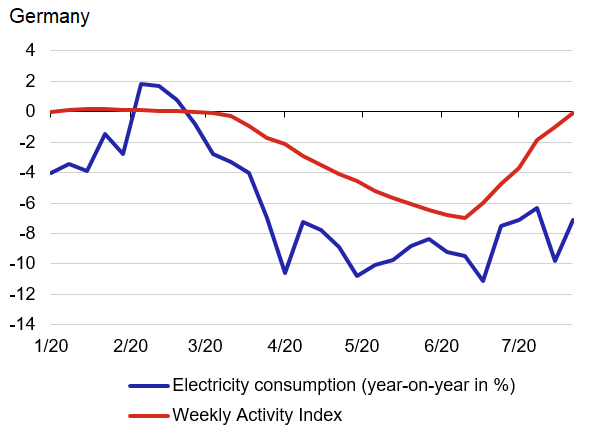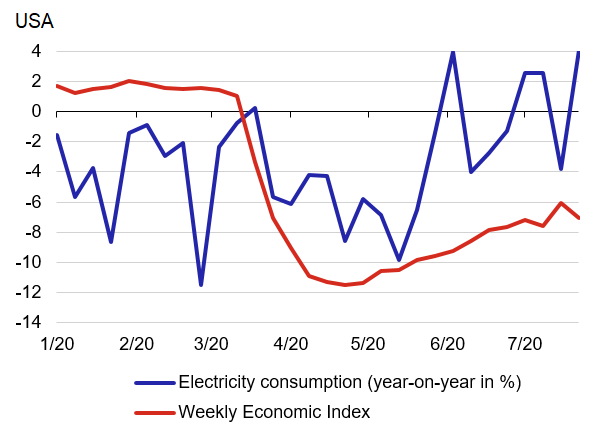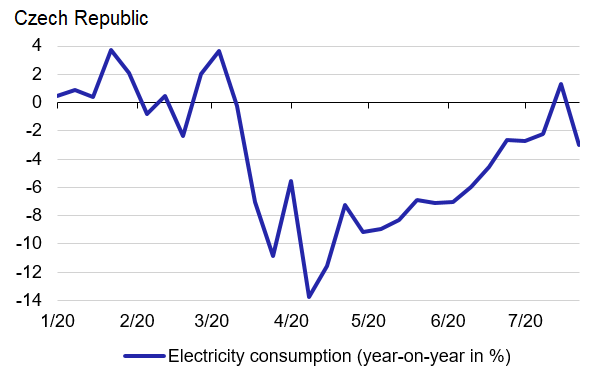High-frequency indicators of economic activity during the Covid-19 pandemic
(authors: Tomáš Adam, Soňa Benecká)
Central banks have started using alternative, high-frequency indicators to monitor economic developments. Lags in the publication of traditional economic data and complications with their collection make it difficult to monitor and interpret current economic developments in dramatic situations such as the Covid‑19 pandemic. By contrast, some high-frequency indicators available on a daily or weekly basis can provide additional information on economic activity with no significant lags, especially in periods of abrupt changes in the economy.[1] For example, monitoring of keywords in internet searches, information on transactions based on payment card data, and trends in the movement of persons can be used to monitor and assess consumer behaviour. The volume of industrial production can be illustrated using data on energy consumption, railroad and air transport, or road tolls collected.
Activity indices published, for example, by the Bundesbank and the Fed provide a more comprehensive view of various sectors of the economy. The Weekly Activity Index for the German Economy[2] comprises nine high-frequency indicators. The data are transformed so that the resulting index describes quarter-on-quarter developments in the German economy, i.e. developments over the last 13 weeks compared with the previous 13 weeks. Besides electricity consumption and tolls collected on German roads, it includes the worldwide number of commercial passenger and cargo flights. The German labour market situation is proxied by the number of internet searches for “unemployment”, “short-time work” and “state support”. The behaviour of German consumers is signalled by the number of passers-by on shopping streets in German cities along with a consumer confidence index. Air pollution data indicate developments in transport. The New York Fed publishes a Weekly Economic Index[3] summarising the evolution of ten high-frequency indicators available for the US economy. These indicators include electricity consumption data, weekly labour market data, and data on retail sales, fuel sales, raw steel production, freight transport and tax collection. Unlike the Bundesbank’s index, this index is scaled to align with the year-on-year growth of the US economy.
These indices suggest that the two large economies have now bottomed out (see Chart 1). The USA reached a trough in late April, when the weekly index fell by more than 11% year on year, whereas Germany did not bottom out until early June (down by almost 7% quarter on quarter). Consumer demand in Germany is recovering quickly, but electricity consumption data are suggesting a more gradual recovery in industrial sectors. By contrast, the Czech economy bottomed out from the perspective of electricity consumption[4] in mid-April, when its year-on-year decline troughed at 13.7%. Since then, all indicators have been improving steadily. At the end of July, the German index was signalling a quarterly decline (i.e. a decline over the last 13 weeks compared with the previous 13 weeks) of 0.1%. The US index fell slightly owing to a rise in unemployment, signalling a year-on-year drop of 7.1%. In the Czech Republic, weekly electricity consumption recorded a year-on-year decline of 3%.
Chart 1 (BOX) High-frequency indicators of economic developments in selected economies
From the perspective of high-frequency indicators, the German, US and Czech economies are past their turning point, but the recovery is gradual



[1] See, for example, “High-frequency” Data Are Especially Useful for Economic Forecasting in Periods of Devastating Crisis, https://www.insee.fr/en/statistiques/4620518?sommaire=4473307.
[2] Weekly Activity Index for the German Economy (WAI), https://www.bundesbank.de/en/statistics/economic-activity-and-prices/weekly-activity-index)
[3] Weekly Economic Index (WEI), https://www.newyorkfed.org/research/policy/weekly-economic-index
[4] The original blog describing the methodology, longer-term correlations and first estimates of the impact of the coronavirus pandemic is available (in Czech only) at: https://www.cnb.cz/cs/o_cnb/cnblog/Prvni-odhad-dopadu-pandemie-COVID-19-na-ekonomiku-CR-zverejneno-8.-4./. The latest update is available at: https://www.cnb.cz/cs/o_cnb/cnblog/Prvni-odhad-dopadu-pandemie-COVID-19-na-ekonomiku-CR/.